Ruth Ellen Gruber's Blog, page 8
June 23, 2012
Smart phone apps for Jewish sites in Warsaw and Berlin
This post also appears on my En Route blog for the Los Angeles Jewish Journal
By Ruth Ellen Gruber
I’ve been on the road for the past 10 days, and I have a backlog of material to catch up on with postings…. both items I have seen online and on-site visits I’ve made myself.
One new development is the release of smart phone apps that guide you around several Jewish sites in Berlin and Warsaw. Smart phone and tablet apps are clearly the self-tour guides of the future that are becoming the present….
The new ones I’ve noticed recently include an app that guides you around the Warsaw of Holocaust hero Janusz Korczak. Called “My Warsaw,” it is a project of the forthcoming Museum of the History of Polish Jews—it’s available for free on the iTunes store, but I’m not sure about other platforms. This is what Virtual Shtetl says:
Berlin has several Jewish cemeteries, including the huge Weissensee cemetery.
This is what Reuters says about the Berlin cemetery app—but I’m not sure where to get the app, or what platforms it serves. I did not find it on iTunes:

By Ruth Ellen Gruber
I’ve been on the road for the past 10 days, and I have a backlog of material to catch up on with postings…. both items I have seen online and on-site visits I’ve made myself.
One new development is the release of smart phone apps that guide you around several Jewish sites in Berlin and Warsaw. Smart phone and tablet apps are clearly the self-tour guides of the future that are becoming the present….
The new ones I’ve noticed recently include an app that guides you around the Warsaw of Holocaust hero Janusz Korczak. Called “My Warsaw,” it is a project of the forthcoming Museum of the History of Polish Jews—it’s available for free on the iTunes store, but I’m not sure about other platforms. This is what Virtual Shtetl says:
The application spans two tourist routes. The first one guides you through places related to Janusz Korczak’s early and late childhood while the other shows Korczak’s life story during World War II. Both routes comprise almost fifty described places. The “My Warsaw-Warszawa jest moja” project shows now nonexistent Warsaw through pictures, audio recordings, a quiz, quotations and the augmented reality system. It sets an example of a novel approach of learning by having fun by means of state-of-the-art technologies.
You can download this bilingual Polish-English application on GooglePlay and AppStore for free.Another new app guides users around three historic Jewish cemeteries in Berlin .
The application is designed to be a modern tool for learning and teaching history. The only thing you have to do is take your Smartphone with you and take a walk with your family around Warsaw or organize a memorable outdoor history lesson. Tourists may use it as a city guide while Warsaw residents may discover their home town anew.
Berlin has several Jewish cemeteries, including the huge Weissensee cemetery.
This is what Reuters says about the Berlin cemetery app—but I’m not sure where to get the app, or what platforms it serves. I did not find it on iTunes:
The smartphone programme leads visitors to the graves of Jewish figures such as philosopher Moses Mendelssohn, hotelier Berthold Kempinski, publishers Rudolf Mosse and Samuel Fischermen and also of those who committed suicide to escape deportation to Nazi death camps.
“There is an Internet code at the entrance of each cemetery which can be scanned by a smartphone and directly connects to the cemeteries’ website,” the cemeteries’ inspector Hilel Goldmann said.
The Internet programme is steered by a GPS navigation device and enables the visitors to plan their own ‘tour’ choosing among about 160 of the 150,000 graves in the three Berlin cemeteries, Goldmann said.
Published on June 23, 2012 06:36
June 7, 2012
NYTimes online on reassessing and reaffirming Jewish Culture in Poland
This post also appears on my En Route blog for the Los Angeles Jewish Journal
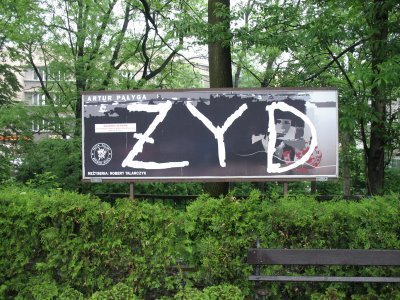 Poster for a play called "Zyd, "or "Jew" by Artur Palyga, which deals with anti-Semitism. Photo (c) Ruth Ellen Gruber
Poster for a play called "Zyd, "or "Jew" by Artur Palyga, which deals with anti-Semitism. Photo (c) Ruth Ellen GruberBy Ruth Ellen Gruber
The development of Jewish - and Jewish-themed—cultural expression and “production” in Poland and other countries is a theme that I have written about for many years, most notably in my book Virtually Jewish: Reinventing Jewish Culture in Europe (BTW—Virtually Jewish is now available as a Kindle e-book.)
I have focused in large part on the relationships between non-Jewish artists, musicians and others with Jewish culture and the way that they have used Jewish themes in their work.
But, in recent years, Jewish artists have also increasingly been exploring Jewish themes and topics, some of them as a way to explore their own identity.
In an article for the New York Times online the journalist Ginanne Brownell reports on this trend, writing about how Jewish artists are reasserting and redefining Jewish culture in Poland. Brownell interviewed me when I was in Poland last month and quotes me in the article—and she also quotes quite a few of my friends!
[A] growing number of Jewish Poles in the artistic sphere ... are exploring the dichotomy of being both Polish and Jewish in 21st-century Poland.
Writers, playwrights, filmmakers and visual artists are tackling everything from anti-Semitism and the Holocaust to coming to terms with their families’ Communist pasts and issues of identity.
“You cannot imagine Polish culture without Jewish culture,” said Pawel Passini, a Lublin-based director and playwright who last year won two awards at the Edinburgh Fringe Festival for his staging of “Turandot.” “I think most people are conscious of that, the problem is how to say it and let people deal with it.”
She goes on:
From the late 1980s — thanks to things like the Krakow Jewish Festival that will take place from June 29 until July 8 this year — Jewish culture, or what is perceived as Jewish culture, has become more popular in Poland. Ms. Gruber described this in her 2002 book “Virtually Jewish” as “familiar exotica,” where there is pseudonostalgia for Jewish culture like the theatrical shtetl world of “Fiddler on the Roof” or wailing, clarinet-infused Klezmer music.
Contemporary Jewish artists are broadening the definition of Jewish culture in Poland. Mr. Passini is a case in point, having become one of the most acclaimed young stage directors in the country. He admits that many of his works — including plays like “Nothing Human” about a young girl trying to find her roots and “Tehillim,” which used choreography based on Hebrew letters — have a focus on spirituality.
Read the full story HERE
Published on June 07, 2012 07:15
May 27, 2012
Regarding Jewish Culture Festivals, as Anchors for Travel
A version of this post originally appeared on my En Route blog for the Los Angeles Jewish Journal
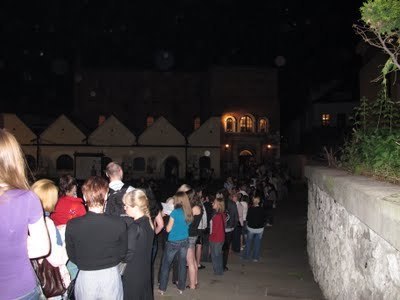 Long line waits to visit Old Synagogue on the Night of Synagogues, 2011. Photo (c) Ruth Ellen Gruber
Long line waits to visit Old Synagogue on the Night of Synagogues, 2011. Photo (c) Ruth Ellen Gruber
By Ruth Ellen Gruber
An article in The Forward advocates something that I have long urged travellers to do—use some of the many Jewish culture and other such festivals in Europe as anchor points for summer travels.
The article highlights just two festivals—the wellknown Jewish Culture Festival in Krakow, and the lesser known festival in Trebic, Czech Republic.
One of the most exciting—and one of the ones that actually has a direct connection to reviving Jewish life—takes place next weekend, June 2-3. It is the second edition of 7@Nite, or what I called the “night of the living synagogues” in Krakow.
On that night, all seven synagogues (and former synagogues) in Krakow’s historic Jewish district, Kazimierz, are open to the public, each one hosting a different event or activity that highlights contemporary Jewish life.
As I wrote in a JTA column last year, after the first 7@Nite:

 Long line waits to visit Old Synagogue on the Night of Synagogues, 2011. Photo (c) Ruth Ellen Gruber
Long line waits to visit Old Synagogue on the Night of Synagogues, 2011. Photo (c) Ruth Ellen GruberBy Ruth Ellen Gruber
An article in The Forward advocates something that I have long urged travellers to do—use some of the many Jewish culture and other such festivals in Europe as anchor points for summer travels.
The article highlights just two festivals—the wellknown Jewish Culture Festival in Krakow, and the lesser known festival in Trebic, Czech Republic.
The Třebíč festival is made up of storytellers, musicians, historians and dancers. Most are local, though some come from nearby Prague; the well-known mix with newcomers, locals who are investigating their history by learning the music, dance and literature of the past.
Krakow and Třebíč offer an alternative way to feel what was lost and experience what remains. Festivals are a means for heritage-oriented tourists to engage in more than anguish; a chance for those who want to experience a center of Jewish culture to do so unabashedly and, in the process, meet locals of a variety of faiths gathered for a communal celebration of Jewish life.
Read more: http://forward.com/articles/156823/fi...But—as I point out in the annual list of festivals that I compile for this blog —there are dozens of Jewish culture and other festivals around Europe each year. My annual list includes only a fraction. There may be as many as 20 or 30 in Poland alone.
One of the most exciting—and one of the ones that actually has a direct connection to reviving Jewish life—takes place next weekend, June 2-3. It is the second edition of 7@Nite, or what I called the “night of the living synagogues” in Krakow.
On that night, all seven synagogues (and former synagogues) in Krakow’s historic Jewish district, Kazimierz, are open to the public, each one hosting a different event or activity that highlights contemporary Jewish life.
As I wrote in a JTA column last year, after the first 7@Nite:
I’ve never seen anything quite like it, even though I’ve followed the development of Kazimierz for more than 20 years—from the time when it was an empty, rundown slum to its position now as one of the liveliest spots in the city.
I’ve witnessed—and chronicled—the development of Jewish-themed tourism, retail, entertainment and educational infrastructure in Krakow, including the Jewish Culture Festival that draws thousands of people each summer. And I’ve written extensively about the interest of non-Jews in Jewish culture.
But Seven at Night was something different. For one thing, nostalgia seemed to play no role. And also, unlike many of the Jewish events and attractions in Kazimierz, this one was organized and promoted by Jews themselves.
It was their show, kicking off with a public Havdalah ceremony celebrated by Rabbi [Boaz] Pash that saw hundreds of people singing and dancing in the JCC courtyard.
Published on May 27, 2012 05:51
May 21, 2012
Hadassah Magazine likes Jewish Heritage Travel
Hadassah Magazine gives a nice review to Jewish Heritage Travel and Jewish Heritage Europe!
"From touring shuls in Ukraine to visiting a Sarajevo Jewish cemetery, travel writer Ruth Ellen Gruber’s blog, jewish-heritage-travel.blogspot.com and Jewish Heritage Europe, jewish-heritage-europe.eu, a new aggregate site coordinated by Gruber, serve as complementary guides to the continent. Jewish Heritage Europe is a comprehensive resource, fostering interest in Jewish heritage sites for academia and tourists. The blog lends a personal touch, for example, by taking readers to a concert at a synagogue in Slovakia."
Published on May 21, 2012 02:33
May 17, 2012
Jewish museums at the European Night of Museums, May 19
This post originally appeared on my En Route blog at the Los Angeles Jewish Journal
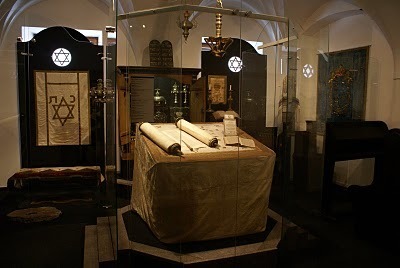 Museum of Jewish Culture in Bratislava, one of the participating institutions. Photo (c) Ruth Ellen Gruber
Museum of Jewish Culture in Bratislava, one of the participating institutions. Photo (c) Ruth Ellen Gruber
By Ruth Ellen Gruber
Jewish museums and other cultural institutions in a number of European countries will be open from dusk on Saturday until the wee hours Sunday as part of the annual European Night of the Museums. The Night of the Museums was founded in 2005, and more than 4,000 institutions in 40 countries took part last year, offering free entrance and special programs for visitors.
This year, Jewish museums and other cultural institutions in Spain, Serbia, Russia, Ukraine, Italy, Slovakia, England, Poland, France, and elsewhere are opening their doors as part of the event. There will be concerts, performances and special exhibits and programs as well as free visits to the museums and institutions themselves.
You can find information for some of the events on the Calendar of the web site www.jewish-heritage-europe.eu
 Museum of Jewish Culture in Bratislava, one of the participating institutions. Photo (c) Ruth Ellen Gruber
Museum of Jewish Culture in Bratislava, one of the participating institutions. Photo (c) Ruth Ellen GruberBy Ruth Ellen Gruber
Jewish museums and other cultural institutions in a number of European countries will be open from dusk on Saturday until the wee hours Sunday as part of the annual European Night of the Museums. The Night of the Museums was founded in 2005, and more than 4,000 institutions in 40 countries took part last year, offering free entrance and special programs for visitors.
This year, Jewish museums and other cultural institutions in Spain, Serbia, Russia, Ukraine, Italy, Slovakia, England, Poland, France, and elsewhere are opening their doors as part of the event. There will be concerts, performances and special exhibits and programs as well as free visits to the museums and institutions themselves.
You can find information for some of the events on the Calendar of the web site www.jewish-heritage-europe.eu
Published on May 17, 2012 11:17
May 14, 2012
More on Oswiecim Life Festival
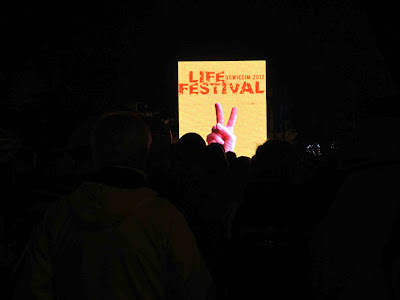 Photo (c) Ruth Ellen Gruber
Photo (c) Ruth Ellen GruberBy Ruth Ellen Gruber
I was very glad to have gone to Oswiecim for the Oswiecim Life Festival, even though I missed the big final stadium concert Sunday night with Peter Gabriel as headliner -- it apparently was Gabriel's only appearance (perhaps first apperance?) in Poland, and I even saw the concert advertised on a city bus in Warsaw. Tickets were pricey, and there was a press center set up in the International Youth Meeting Center, next to the stadium.
I stayed at the Center -- run by a German foundation, it hosts groups on study tours to Auschwitiz and organizes programs on tolerance and dialogue. (When I went in for breakfast, two tables occupied by burly young men were designated "Hamburg Polizei.) The Center has been around since 1986, and I wrote about it in my 1994 book Upon the Doorposts of Thy House, whose final chapter is a day to day description of my being snowbound in Oswiecim for nearly 4 days, and a reflection on how the shadow of the Auschwitz camp looms over the city.
Saturday afternoon, the Center hosted an intense -- and hours-long -- panel discussion on hate speech in the Polish internet scene and what can be done to combat it. Tomek Kuncewicz of the Auschwitz Jewish Center told me that he would like to see future editions of the Life Festival include more workshops and other events like this.
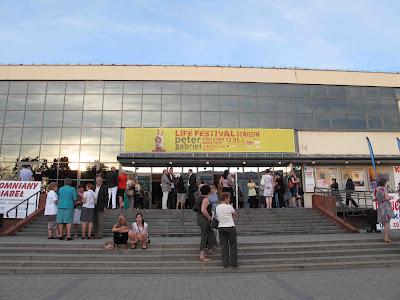 Outside the theatre. Photo (c) Ruth Ellen Gruber
Outside the theatre. Photo (c) Ruth Ellen GruberBesides concerts and a theatre performance, the Festival also sponsored public art projects -- a big mural, as well as other murals painted on walls around town that featured Polish and other figures of moral authority (Pope John Paul II, Vaclav Havel, Jacek Kuron, etc) with quotations from them about civil rights, tolerance, etc etc.
The one of the pope -- painted near the market square just opposite the city's main church -- specifically addressed anti-Semitism.
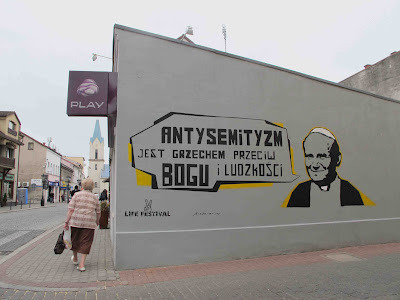 "Anti-Semitism is a Sin against God and Humanity" Photo (c) Ruth Ellen Gruber
"Anti-Semitism is a Sin against God and Humanity" Photo (c) Ruth Ellen GruberAt the Life Festival, I did go to the free concert Saturday night in the Rynek, or town square -- a space that is slated for redevelopment this summer.
The concert began in cold rain -- only a handful of people braved the weather to hear the Israeli Schahar Gilad band. I went for dinner with friends and then came back for the final set -- a terrific performance by a legenday Polish blues rock band called Dzem, which has been around for 25 years or so..... The weather had cleared and the square was packed.
We stood at the very back of the crowd, on the edge of the square -- it was worth it just two watch this dude get into the music:
Published on May 14, 2012 01:07
May 12, 2012
Life Festival in Oswiecim
This post originally appeared on my En Route blog for the Los Angeles Jewish Journal
By Ruth Ellen Gruber
I’ve been in Warsaw the past week and just came down yesterday to Oswiecim—the little city in southern Poland outside of which Auschwitz is located. I’m not here to pay homage at the death camp (which I have visited a number of times) but to attend part of the third edition of the Oswiecim Life Festival, which is aimed at using (mainly) youth-oriented music and arts to promote tolerance. There are concerts (I’ll have to miss the biggie—Peter Gabriel and others Sunday night in the local stadium), performances, educational programs and public meetings. Last year, Matisyahu was the headliner—I wrote about it in a JTA article about the city of Oswiecim wrestling with its past.
Last night, I went with my friend Tomek Kunciewicz, the director of the Auschwitz Jewish Center, to a stage performance in the town’s theatre, which is part of the local cultural center. It was the Polish language version of the English play “Shirley Valentine,” and starred the great Polish actress Krystyna Janda. Ahead of the play was the formal presentation of a mural symbolizing the arts and peace—each year another, different mural on these themes is painted on a city wall and left there as a permanent reminder of the Festival.
By Ruth Ellen Gruber
I’ve been in Warsaw the past week and just came down yesterday to Oswiecim—the little city in southern Poland outside of which Auschwitz is located. I’m not here to pay homage at the death camp (which I have visited a number of times) but to attend part of the third edition of the Oswiecim Life Festival, which is aimed at using (mainly) youth-oriented music and arts to promote tolerance. There are concerts (I’ll have to miss the biggie—Peter Gabriel and others Sunday night in the local stadium), performances, educational programs and public meetings. Last year, Matisyahu was the headliner—I wrote about it in a JTA article about the city of Oswiecim wrestling with its past.
Last night, I went with my friend Tomek Kunciewicz, the director of the Auschwitz Jewish Center, to a stage performance in the town’s theatre, which is part of the local cultural center. It was the Polish language version of the English play “Shirley Valentine,” and starred the great Polish actress Krystyna Janda. Ahead of the play was the formal presentation of a mural symbolizing the arts and peace—each year another, different mural on these themes is painted on a city wall and left there as a permanent reminder of the Festival.
Published on May 12, 2012 05:16
May 11, 2012
This post first appeared in The Jew & the Carro...
This post first appeared in The Jew & the Carrot blog of The Forward Stuffed Cabbage From the Polish Border By Ruth Ellen Gruber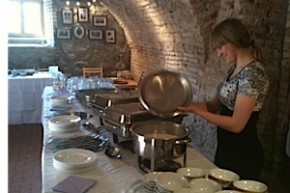 Photo: Mayhill Fowler
Photo: Mayhill Fowler
SEJNY, POLAND — The first time I visited Lithuania in 2006 I was overwhelmed by the extraordinary sensation that I was traveling through a giant Jewish deli that extended across the entire country. Blintzes! Latkes! Sour cream! Herring! Smoked fish! Black bread! And even — on the breakfast buffet of one hotel I stayed in — vodka, at 8 in the morning.
Recently I spent a week in the far northeast of Poland in the town of Sejny, so close to the border with Lithuania that my cell phone kept jumping back and forth between the two national networks.
I was there for a series of events hosted by Borderland Foundation, an organization that works toward inter-ethnic cultural and artistic interchange, along with promoting an understanding of Jewish culture, heritage and memory.
Throughout the week, a range of symposia, concerts and debates, hosted at an old Yeshiva and at a manor house where the Nobel-prizewinning Polish poet Czeslaw Milosz spent holidays in his youth, provided much food for thought. At the same time, a veritable feast for the palate was provided by two local chefs — Grażyna Łowiagin, who runs a country restaurant call Gospoda in the nearby village of Dusznica, and Wojtek Konikowski, who heads the kitchen at the Skarpa restaurant in Sejny — who served a range of wonderful local specialties each day at lunch and dinner. It was East European comfort food at its best: bliss for me, as I just can’t find this type of cuisine in Italy, where I spend much of my time.
Meals featured traditional regional dishes found in this border area of Poland and Lithuania. We had potato pancakes served with sour cream sauce; kartacze — huge, chewy potato dumplings stuffed with meat or white cheese; kiszka (kishkes; intestines) stuffed with potato; and soczewiaki and kakory — deep fried or baked potato cakes stuffed with lentils and kasha: they are so characteristic of the region that they have been registered on a list of traditional products. Soups included chlodnik (cold borsht with cream and dill); and cucumber soup. For dessert, there was a dry, semi-sweet cake called sekacz, shaped like a miniature tree.
One standout dish was a vegetarian version of golabki, or stuffed cabbage — a dish found in many varieties all over eastern and central Europe. In Yiddish it’s called holishkes and is often served at Sukkot, topped with a sweet and sour sauce made with tomatoes, apples and raisins.
Stuffed cabbage it is typically made with a meat filling, and I have to say that I never really liked my mother’s own recipe that called for a filling of minced meat and rice, but chef Konikowski at the Skarpa restaurant prepared a delectable version stuffed with kasha and mushrooms, accompanied by a sauce made from double cream and mushrooms.
I persuaded chef Jonikowksi to part with his recipe for kasha and mushroom stuffed cabbage. His quantities and measures are a little ad hoc, and he warned me that much of the recipe had to be carried out “to taste,” including how long to bake it at the end.
Filling:
2.2 pounds Kasha (buckwheat groats) (You may not need this much!)
Salt, black pepper
One egg
3-4 tablespoons breadcrumbs
12 ounces chopped fresh mushrooms
Boil the kasha, drain then let it cool (wholegrain kasha should take about 20 minutes)
Saute the chopped mushrooms in butter until tender (some cooks also like to sautéed chopped onions). Remove from heat and let cool down.
Add the egg, breadcrumbs and sautéed mushrooms (and onions if used) to the kasha, season to taste with salt and pepper and mix well.
Wrappers:
Remove the hard stalk and boil one whole head of cabbage until the leaves can be removed whole – white cabbage will do (and is what Konikowski used for the golabki he served us, but he says he actually prefers Savoy cabbage, which gives a more delicate flavor and texture.) This can take up to 40 minutes. Some cooks remove the outer layers as they become tender, leaving the inner ones to cook.
Remove any hard core from the leaves
Place stuffing on the leaves and roll them into envelopes, folding over the edges to put the “seam” underneath.
Place the rolls, seam down, tightly packed into a pan greased with butter, add water to just cover the rolls, cover and then bake for about 20 minutes in a 400 degree oven. You can then uncover and bake for another 10 minutes or so to let the rolls brown.
Sauce:
Saute mushrooms in butter; stir in sour cream or double cream until it reaches the “runniness” and consistency you prefer. Season with salt, pepper to taste and pour over the hot cabbage dumplings.
Read more: http://blogs.forward.com/the-jew-and-the-carrot/155951/stuffed-cabbage-from-the-polish-border/#ixzz1uXyjmns4
 Photo: Mayhill Fowler
Photo: Mayhill Fowler SEJNY, POLAND — The first time I visited Lithuania in 2006 I was overwhelmed by the extraordinary sensation that I was traveling through a giant Jewish deli that extended across the entire country. Blintzes! Latkes! Sour cream! Herring! Smoked fish! Black bread! And even — on the breakfast buffet of one hotel I stayed in — vodka, at 8 in the morning.
Recently I spent a week in the far northeast of Poland in the town of Sejny, so close to the border with Lithuania that my cell phone kept jumping back and forth between the two national networks.
I was there for a series of events hosted by Borderland Foundation, an organization that works toward inter-ethnic cultural and artistic interchange, along with promoting an understanding of Jewish culture, heritage and memory.
Throughout the week, a range of symposia, concerts and debates, hosted at an old Yeshiva and at a manor house where the Nobel-prizewinning Polish poet Czeslaw Milosz spent holidays in his youth, provided much food for thought. At the same time, a veritable feast for the palate was provided by two local chefs — Grażyna Łowiagin, who runs a country restaurant call Gospoda in the nearby village of Dusznica, and Wojtek Konikowski, who heads the kitchen at the Skarpa restaurant in Sejny — who served a range of wonderful local specialties each day at lunch and dinner. It was East European comfort food at its best: bliss for me, as I just can’t find this type of cuisine in Italy, where I spend much of my time.
Meals featured traditional regional dishes found in this border area of Poland and Lithuania. We had potato pancakes served with sour cream sauce; kartacze — huge, chewy potato dumplings stuffed with meat or white cheese; kiszka (kishkes; intestines) stuffed with potato; and soczewiaki and kakory — deep fried or baked potato cakes stuffed with lentils and kasha: they are so characteristic of the region that they have been registered on a list of traditional products. Soups included chlodnik (cold borsht with cream and dill); and cucumber soup. For dessert, there was a dry, semi-sweet cake called sekacz, shaped like a miniature tree.
One standout dish was a vegetarian version of golabki, or stuffed cabbage — a dish found in many varieties all over eastern and central Europe. In Yiddish it’s called holishkes and is often served at Sukkot, topped with a sweet and sour sauce made with tomatoes, apples and raisins.
Stuffed cabbage it is typically made with a meat filling, and I have to say that I never really liked my mother’s own recipe that called for a filling of minced meat and rice, but chef Konikowski at the Skarpa restaurant prepared a delectable version stuffed with kasha and mushrooms, accompanied by a sauce made from double cream and mushrooms.
I persuaded chef Jonikowksi to part with his recipe for kasha and mushroom stuffed cabbage. His quantities and measures are a little ad hoc, and he warned me that much of the recipe had to be carried out “to taste,” including how long to bake it at the end.
Filling:
2.2 pounds Kasha (buckwheat groats) (You may not need this much!)
Salt, black pepper
One egg
3-4 tablespoons breadcrumbs
12 ounces chopped fresh mushrooms
Boil the kasha, drain then let it cool (wholegrain kasha should take about 20 minutes)
Saute the chopped mushrooms in butter until tender (some cooks also like to sautéed chopped onions). Remove from heat and let cool down.
Add the egg, breadcrumbs and sautéed mushrooms (and onions if used) to the kasha, season to taste with salt and pepper and mix well.
Wrappers:
Remove the hard stalk and boil one whole head of cabbage until the leaves can be removed whole – white cabbage will do (and is what Konikowski used for the golabki he served us, but he says he actually prefers Savoy cabbage, which gives a more delicate flavor and texture.) This can take up to 40 minutes. Some cooks remove the outer layers as they become tender, leaving the inner ones to cook.
Remove any hard core from the leaves
Place stuffing on the leaves and roll them into envelopes, folding over the edges to put the “seam” underneath.
Place the rolls, seam down, tightly packed into a pan greased with butter, add water to just cover the rolls, cover and then bake for about 20 minutes in a 400 degree oven. You can then uncover and bake for another 10 minutes or so to let the rolls brown.
Sauce:
Saute mushrooms in butter; stir in sour cream or double cream until it reaches the “runniness” and consistency you prefer. Season with salt, pepper to taste and pour over the hot cabbage dumplings.
Read more: http://blogs.forward.com/the-jew-and-the-carrot/155951/stuffed-cabbage-from-the-polish-border/#ixzz1uXyjmns4
Published on May 11, 2012 01:21
May 8, 2012
This post originally appeared on my En Route blog for the...
This post originally appeared on my En Route blog for the Los Angeles Jewish Journal
By Ruth Ellen Gruber
Hmm. I spent much of the morning in Warsaw today talking with an E-Book and App publisher about creating apps and interactive E-Books from my own writing, on various platforms. So I am quite convinced that going mobile is the way to get around. Still, I’m somehow a little teentsy weentsy bit uneasy with “Anne Frank’s Amsterdam” —even though it clearly is a very serious project aimed to instruct visitors while showing the city. It is available on various smart phone platforms, and created by Anne Frank House. Maybe it’s just the promotional aspect of the project….From the Anne Frank House website:

By Ruth Ellen Gruber
Hmm. I spent much of the morning in Warsaw today talking with an E-Book and App publisher about creating apps and interactive E-Books from my own writing, on various platforms. So I am quite convinced that going mobile is the way to get around. Still, I’m somehow a little teentsy weentsy bit uneasy with “Anne Frank’s Amsterdam” —even though it clearly is a very serious project aimed to instruct visitors while showing the city. It is available on various smart phone platforms, and created by Anne Frank House. Maybe it’s just the promotional aspect of the project….From the Anne Frank House website:
discover for yourself Anne Frank’s and her contemporaries’ stories at thirty special places in the city with the Anne’s Amsterdam mobile application. The Anne Frank House has developed this App together with Repudo and LBi with the aim of making the city’s wartime history better known. Anne’s Amsterdam is available in Dutch, English and German and suitable for smart phones with iOS, Android and WP7.
With Anne’s Amsterdam you can view personal stories, film footage and unique photographs from the past at the same location today. There are images of Anne Frank and her friends on the Merwedeplein, German troops entering the city on the Rokin and the raid on the Jonas Daniël Meijerplein. This link between the past and the present enables you see the city in a different way by which events of the war come to life. You can collect the stories, films and photos for your digital album on your telephone. You can also send your items per e-mail and encourage others to use the App via Facebook and Twitter.
The items collected link to the website Anne Frank’s Amsterdam. A visual timeline gives in depth information and context. Personal stories, not previously published on the internet, from Jewish and non-Jewish eyewitnesses give a view of life during the occupation. The period before and after the occupation are also discussed, placing Amsterdam’s war time history in a broader perspective.I will download it—hope it works with the iPad!
Published on May 08, 2012 08:59
May 6, 2012
Synagogues in Northeastern/Eastern Poland
This post first appeared on my En Route blog for the Los Angeles Jewish Journal
By Ruth Ellen Gruber
I spent the past week in Sejny, a small town in the far northeast of Poland near the Lithuanian border—and coincidentally just ran across a very good video about the synagogues and Jewish quarters in Sejny and several other towns in eastern/northeastern Poland. It’s worth watching.
The video deals with the synagogues and Jewish districts in Sejny, Orla, Tykocin, and Bialystok. Lena Bergman, of the Jewish Historical Institute and one of the foremost experts on Jewish heritage in Poland, describes the architecture of the buildings and also the historical context in which they were/are set.
The 17th century synagogue in Tykocin was rebuilt in the 1970s as a Jewish Museum; that in Sejny, the so-called “White Synagogue”, now forms part of the premises of the Borderland Foundation, an innovative organization devoted to cultural, social and artistic interchange. (I was in Sejny for celebrations marking Borderland’s 22nd anniversary.)
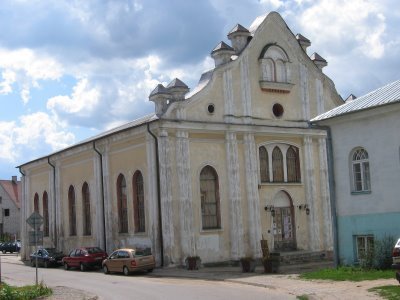 The White Synagogue in Sejny. Photo (c) Ruth Ellen Gruber
The White Synagogue in Sejny. Photo (c) Ruth Ellen Gruber
Published on May 06, 2012 10:25



